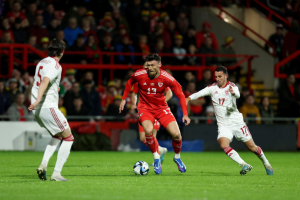- Pollution regulations hit rural areas hardest
- Red tape hits Local Development Plans in areas of most need
- Social housing projects under review
- Much-needed schemes may not go ahead
THE QUIET introduction of new pollution regulations in January risk making Wales’s housing crisis even more severe in counties where the boom in holiday investment properties and second home buyers have already priced many locals out of the housing market.
In January of this year, NRW introduced phosphate control regulations to protect watercourses and rivers in Special Areas of Conservation.
Those regulations particularly affect parts of Wales that need affordable housing to counterbalance spiralling rents and property prices.
The nine rivers affected by the rule changes are the catchment areas for the Cleddau, Eden, Gwyrfai, Teifi, Tywi, Glaslyn, Dee, Usk and Wye.
REGULATIONS HIT HOUSING PLANS

Among the regulations’ unintended consequences are two substantial issues for local planning authorities and builders.
When drawing up sewerage proposals for any development, the first presumption must always provide for a system of foul drainage discharging into a public sewer. If that isn’t an option, developers must build their own sewage package plant to avoid pollution. Septic tanks will be allowed only in minimal circumstances for any development.
Secondly, and more seriously, each of the planning authorities in the affected areas must revisit their Local Development Plans and screen every application already submitted to see if it meets the phosphate pollution targets.
That last point carries serious consequences for areas identified for housebuilding and commercial development.
Areas already designated for development within existing Local Development Plans (LDPs) must be reconsidered because of the new regulations.
Those areas for which development proposals have been submitted for future LDPs (the ongoing processes for which started in 2017) must also be screened.
As an LDP’s function addresses future residential and commercial property needs, the regulations will have a chilling effect on meeting those needs.
OUR QUESTIONS
We asked Carmarthenshire, Pembrokeshire, Ceredigion, Powys, Gwynedd, Ynys Mon/Anglesey Councils the same three questions.
Neither Gwynedd nor Ynys Mon responded by our deadline.
What assessment has the local authority made of the impact of the new regulations on phosphate emissions and pollution control in respect of:
a) housing and commercial developments for which either outline or full permission has already been granted;
b) the capacity to deliver social housing; and
c) Local Development Plans and sites earmarked for development within them?
The answers are uncomfortable reading for those hoping to get on the housing ladder.
RURAL CARMARTHENSHIRE TAKES REGULATIONS HIT

A spokesperson for Carmarthenshire County Council told The Herald: “Whilst the Council is fully aware of the importance of conserving and enhancing the water quality of our rivers for our future generations, it also recognises the potentially significant social and economic implications arising from the publication of the NRW guidance – most notably from a developmental / investment perspective.
“In geographical terms, it is the north and north-eastern parts of the County which are currently impacted, with the Council having to take a precautionary approach in considering and determining development proposals to ensure compliance with regulatory frameworks.
“Although this is an environmental issue, it impacts the future delivery of homes (including social housing) and creation of jobs in the affected areas – mainly rural parts of the County.
“It also has implications for the emerging Revised Local Development Plan and its content within those areas affected by the phosphate guidance.
“Carmarthenshire has taken a proactive approach to the issue of phosphates and is identifying the way forward, including providing further guidance on its impact.
“Cllr Emlyn Dole, Leader, has already raised the issue in writing with the First Minister and the challenges it poses to some of our rural areas and Covid recovery.”
CEREDIGION FACES HUGE HOUSING SHORTFALL

Ceredigion County Council told us: “In terms of housing and outline consent, we anticipate that 11 units approved in outline are likely to be impacted and potentially up to 504 units approved in full are impacted where development has not been completed, and discharge of conditions remain outstanding particularly those relating to surface water run-off and foul sewerage; however, we cannot provide an exact total at this time.
“In terms of commercial developments potentially up to 27 consents approved are impacted where development has not completed and discharge of conditions remain outstanding particularly those relating to surface water run-off and foul sewerage; however, an exact total cannot be provided at this time.”
In response to our question regarding social housing provision, we were told: “No formal analysis of delivery of social housing has as yet been undertaken; work remains ongoing.”
The big kicker was the response to our third question. Hundreds of potential houses are caught by the regulations.
Ceredigion County Council said: “In terms of the current LDP, 14 allocated housing sites are affected, equating to the potential yield of 572 houses of which 114 would likely be affordable.
“In terms of employment and mixed-use sites 6 sites are impacted equating to 28% and 20% respectively of all non-housing sites.”
CONWY CONSIDERS WATER MANAGEMENT

Conwy County Borough Council told The Herald: “The Planning Policy Service is engaged with NRW and Welsh Water with the focus on managing any impact from proposed Local Development Plan sites or for any future applications.
“At this point, no land allocations are identified in the catchment areas.
“Where required, we are working to establish solutions to mitigate the impact of phosphates.
“Land policies will be developed that seek to provide sustainable solutions. We will need to work with developers, local authorities, land managers, Welsh Water and NRW to deliver a range of solutions.
“It’s our view that developing land allocations policies which invest in catchment solutions such as planting buffer strips alongside rivers, managing nutrient and manure addition, as well as creating wetlands to better manage runoff into the rivers, will have a more beneficial and sustainable impact.”
PEMBROKESHIRE FACES SOCIAL HOUSING DELAY

A spokesperson for Pembrokeshire County Council told us: “The new guidance does not impact on developments for which full permission has already been granted.
“It does impact proposals which have only gained outline permission and do not yet have reserved matters permission.
“Reserved matters submissions in areas which cannot demonstrate that they accord with the guidance are unlikely to be granted planning permission.”
In respect of social housing, the Council says it is working closely with its delivery partners.
“We have made both PCC Housing colleagues and Registered Social Landlords (RSLs) operating in Pembrokeshire aware of the implications of the new guidance from Natural Resources Wales,” the spokesperson said.
“In the short/medium term, this means that both PCC and local RSLs are likely to delay progressing sites in the areas affected and instead focus on areas which are not impacted by the new guidance.
“Information from our Housing team suggests there are three affordable housing sites currently in pre-planning stage by local RSLs which are currently on hold.
“In total, these sites would have delivered 171 affordable homes.”
The spokesperson gave a sobering account of the housing sites hit by the regulations, saying: “PCC’s assessment is that of the housing sites identified in LDP 2 Deposit Plan (consulted on in Jan-March 2020), there are 313 homes identified on sites in locations which are currently undeliverable and at risk of de-allocation.
“Settlements with sites at risk of de-allocation include Abercych, Cilgerran, Clarbeston Road, Keeston, Letterston, Llanddewi Velfrey, Narberth and Wolfscastle.
“PCC estimate that the area of Pembrokeshire affected would also normally expect to see approximately 150 windfall homes built between 2021 and 2033, which are also currently undeliverable.
“Two employment allocations and an allocation in Narberth for specialist and supported accommodation are also not currently able to demonstrate that they meet the requirements of the guidance.”
The Council is now waiting on an assessment from Dwr Cymru on how the regulations could hit other developments.
We were told: “Some LDP2 sites may be able to remain in the Plan if Dwr Cymru confirms investment in phosphates treatment at Wastewater Treatment Works as part of their AMP 8 programme.
“The Council is also actively working with partner organisations, Natural Resources Wales and neighbouring Authorities to explore opportunities for nature-based solutions and off-setting, learning from approaches undertaken by English Local Planning Authorities in response to similar issues.
“The Council is attending meetings of the all-Wales Planning Sub-Group on this issue.
“Pembrokeshire County Council’s Cabinet Member for Planning Jon Harvey has written to Julie James MS and Lesley Griffiths MS to raise concerns about the implications of this guidance on development in Pembrokeshire and on the Pembrokeshire Local Development Plan.”
Both Dwr Cymru and Natural Resources Wales have been invited to attend seminars with Pembrokeshire’s County Councillors to update their work about phosphates.
POWYS TO RE-EXAMINE DEVELOPMENT PLAN

A spokesperson for Powys County Council told us: “For Powys, the guidance affects the whole of the catchments of River Wye and River Usk Special Areas of Conservation.
“This means that all planning applications within the SAC catchments that would generate organic matter (i.e., wastewater, manure) are affected and need to demonstrate that they will not add additional phosphate to the river SACs if they are to be permitted.
“As part of national work, we are reviewing the implications of the NRW guidance examining the geographic area affected, implications for the National Development Plan and settlements in the local development plan affected by the guidance.
“Work on a replacement LDP for Powys (excluding the Brecon Beacons National Park) is expected to commence in mid-2022.
“Any sites proposed for development will need to take account of NRW’s guidance.
“We are dealing with planning applications on a case-by-case basis to identify whether or not they would generate organic matter; some will, and others won’t.
“It will be possible for some applications to be permitted where developers can find avoidance or mitigation (solutions) in line with NRW’s advice.
“Where these can’t be found, applications are unlikely to obtain planning permission because of the likely significant effect they would have on the SAC and the habitats and species that it supports.”
PHOSPHATES: WHAT IS THE PROBLEM?

In 2019, the Joint Nature Conservation Committee (JNCC) recommended that UK nature conservation organisations adopt tighter targets after considering new evidence about the environmental impacts of phosphate.
Phosphate can cause significant ecological damage to rivers and can lead to rivers losing biodiversity. Although phosphorous is a naturally occurring plant nutrient, too much of it in water leads to problems.
Nutrient pollution is a major cause of algal blooms and excess growth of other aquatic plants leading to overcrowding competition for sunlight, space, and oxygen. It kills plants, invertebrates, and fish wrecking delicately balanced ecosystems.
In addition, the predicted warmer and drier weather resulting from climate change could reduce river flows during the summer and increase phosphate concentrations.
Once phosphate pollution occurs, it is challenging for natural habitats to recover, and the work needed to support recovery is very expensive.
Housebuilding is a major source of phosphate pollution.
Wastewater from homes must go somewhere, and surface water run-off from housing leads to phosphate pollution.

















